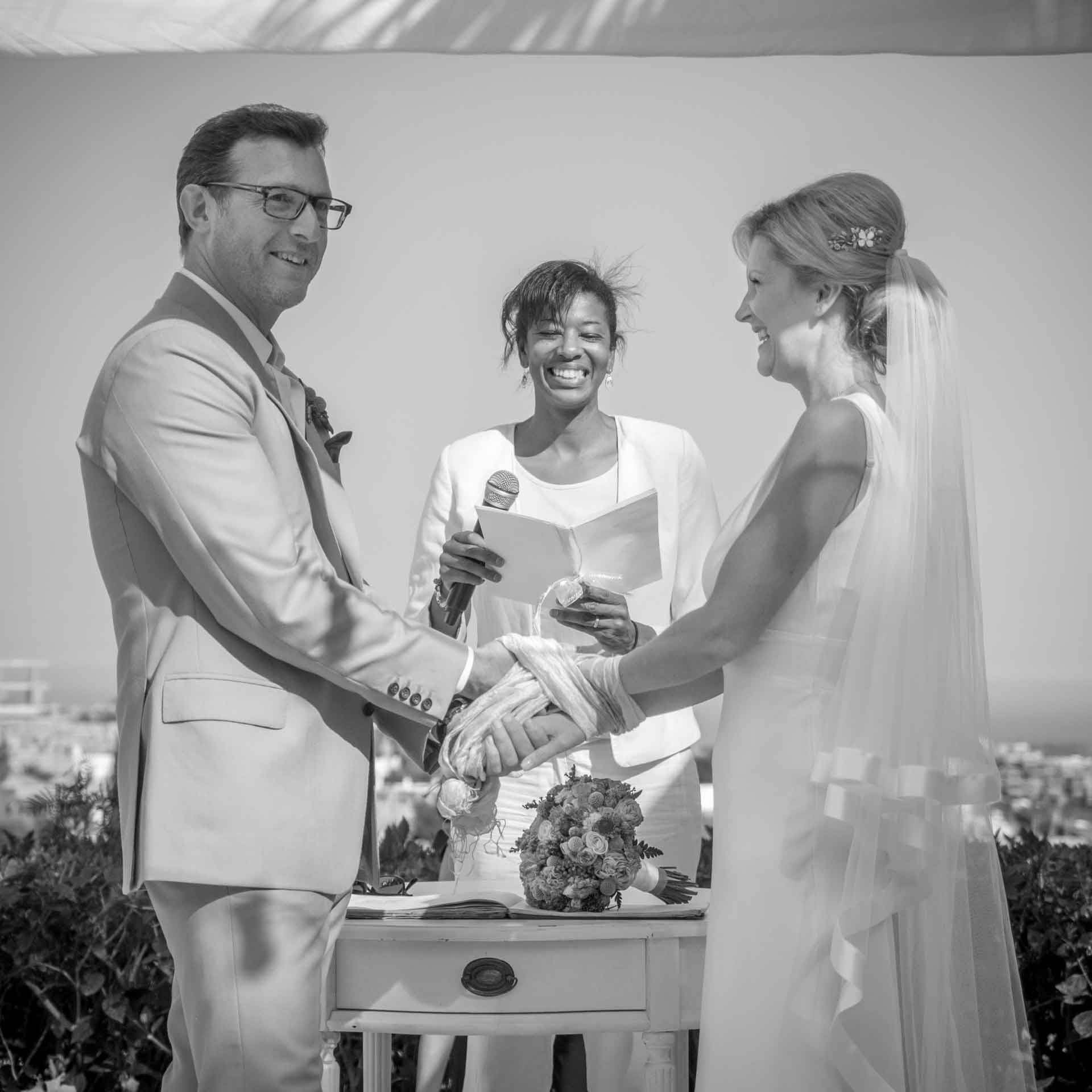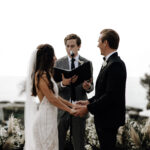Hey there, wedding officiant! Jen Glantz here. As a professional speech writer, I’m ready to help your write a memorable wedding ceremony speech. Let’s look at wedding officiant speech ideas.
Being asked to officiate a wedding is both an honor and a challenge. As someone who’s been on both sides of the altar, I can tell you that crafting the perfect officiant speech is no small feat. But fear not! I’ve put together 50 creative ideas to help you make that special day truly unforgettable.
Whether you’re a seasoned pro or a first-timer, these ideas will help you create a ceremony that’s as unique as the couple you’re celebrating. From traditional religious ceremonies to quirky themed affairs, we’ve got you covered.
Use these additional resources:
- Our handy Wedding Officiant Speech Generator
- Our comprehensive Wedding Officiant Speech Guide
- A list of Wedding Officiant Speech Jokes
- A list of Wedding Officiant Speech Templates
- A guide of Wedding Officiant Quotes
- How to craft a Funny Wedding Officiant Speech
Key Takeaways
- Understand legal requirements and balance personal elements with ceremonial structure
- Tailor your speech to the couple’s preferences and diverse audience
- Incorporate the couple’s love story and find the right balance of humor and sentiment
- Practice delivery and have backup plans for technical issues
- Choose from traditional, non-religious, humorous, unique, or brief ceremony styles
- Adapt your chosen style to meet legal requirements and engage all guests
- Consider seeking professional help for perfecting your officiant speech
Understanding the Role of a Wedding Officiant
As a wedding officiant, you’re not just there to say a few words and pronounce the couple married. You’re the maestro of the ceremony, orchestrating a beautiful moment that the couple will remember for the rest of their lives. It’s a big responsibility, but don’t let that intimidate you. With the right preparation, you can create a ceremony that’s both meaningful and memorable.
First things first: you need to understand the legal requirements of being a wedding officiant. Each state has different rules, so do your homework. You might need to get ordained, register with the local government, or meet other specific criteria. Don’t leave this to the last minute – nothing ruins a wedding faster than finding out the officiant isn’t legally allowed to perform the ceremony!
Once you’ve got the legal stuff sorted, it’s time to focus on the ceremony itself. Your job is to create a ceremony that reflects the couple’s wishes while maintaining the structure and solemnity of a wedding. It’s a delicate balance, but getting it right is what makes a ceremony truly special.
Knowing Your Audience
When I officiated my first wedding, I made the rookie mistake of assuming everyone in the audience shared the same background and beliefs as the couple. Boy, was I wrong! Weddings often bring together a diverse group of people, and as the officiant, it’s your job to create a ceremony that resonates with everyone present.
Start by discussing the guest list with the couple. Are there multiple religions or cultures represented? Are there generational differences to consider? Understanding the makeup of your audience will help you craft a ceremony that’s inclusive and engaging for everyone.
If you’re incorporating elements from specific cultural or religious traditions, take the time to research them thoroughly. There’s nothing worse than mispronouncing a key term or misrepresenting a significant ritual. When in doubt, consult with family members or cultural experts to ensure accuracy.
Language is another crucial consideration. If you’re officiating a multilingual wedding, consider incorporating elements in multiple languages. Even if it’s just a few key phrases, this gesture can go a long way in making all guests feel included.
Crafting a Meaningful Speech
Now we’re getting to the heart of the matter – the speech itself. This is where you get to shine as an officiant, creating a ceremony that’s both personal and profound. But where do you start? How do you strike the right balance between humor and sentiment? And how do you make sure your words resonate with both the couple and their guests?
First and foremost, get to know the couple’s story. Schedule a time to sit down with them and really dig into their relationship. How did they meet? What drew them together? What are their shared values and dreams for the future? These personal anecdotes and insights will form the backbone of your speech.
As you’re crafting your speech, think about the overall narrative you want to create. A great wedding ceremony tells a story – the story of two people coming together and committing to a shared future. Use the couple’s personal anecdotes to illustrate this journey, building towards the emotional high point of their vows and ring exchange.
Use these additional resources:
- Our handy Wedding Officiant Speech Generator
- Our comprehensive Wedding Officiant Speech Guide
- A list of Wedding Officiant Speech Jokes
- A list of Wedding Officiant Speech Templates
- A guide of Wedding Officiant Quotes
- How to craft a Funny Wedding Officiant Speech
50 Creative Wedding Officiant Speech Ideas to Make Your Ceremony Unforgettable
Opening Techniques
1. The Time Capsule Opening
Begin your speech by revealing contents from a time capsule the couple created during their engagement, sharing items that represent their journey together.
2. The Love Letter Exchange
Start by reading excerpts from love letters the couple wrote to each other specifically for the ceremony.
3. The Origin Story
Open with the exact moment, date, and time the couple met, including amusing or touching details that only close friends would know.
4. The Cultural Fusion Introduction
Begin with greetings in all the languages represented by the couple’s heritage, celebrating their multicultural union.
5. The Quote Collection
Start with a carefully curated collection of quotes about love from the couple’s favorite books, movies, or songs.
Personal Stories
6. The Friend’s Perspective
Share your unique viewpoint as someone who witnessed their love story unfold, including specific moments that showed their compatibility.
7. The Growth Chronicle
Highlight how both individuals have grown and evolved through their relationship, using concrete examples.
8. The Relationship Milestones
Walk through significant moments in their relationship, tying each to a universal truth about love.
9. The Family Integration Story
Share how each person has become an integral part of their partner’s family, with specific anecdotes.
10. The Shared Passion Narrative
Focus on the couple’s common interests and how these have strengthened their bond.
Unique Structural Approaches
11. The “Recipe for Love”
Structure the speech as a recipe, listing ingredients (their qualities) and instructions (their journey together).
12. The Seasonal Metaphor
Frame their relationship through the lens of seasons, highlighting how their love has weathered different periods.
13. The Adventure Map
Present their love story as an epic journey, complete with challenges overcome and treasures discovered.
14. The Love Dictionary
Define their relationship through custom “dictionary entries” that capture their unique bond.
15. The Musical Composition
Structure the speech like a piece of music, with movements representing different aspects of their relationship.
Interactive Elements
16. The Audience Participation
Incorporate brief moments where guests participate in the ceremony through responses or gestures.
17. The Memory Collection
Include collected memories from wedding guests, woven into a narrative.
18. The Group Blessing
Guide guests in a collective blessing or well-wishing moment.
19. The Unity Ritual Narration
Narrate a unique unity ceremony that reflects the couple’s personalities.
20. The Collaborative Vow Creation
Lead the couple in creating a portion of their vows together during the ceremony.
Cultural and Traditional Elements
21. The Heritage Celebration
Incorporate traditional wedding blessings from both families’ cultures.
22. The Ancestral Tribute
Honor family traditions while creating new ones for the couple’s future.
23. The Symbolic Integration
Explain cultural symbols and their significance to the couple’s union.
24. The Generation Bridge
Connect the couple’s love story to their family histories and future legacy.
25. The Ritual Explanation
Thoughtfully describe the meaning behind each cultural element in the ceremony.
Modern Twists
26. The Social Media Story
Incorporate highlights from their social media journey together (with permission).
27. The Hashtag History
Share the story behind their wedding hashtag and how it represents them.
28. The Digital Love Letter
Include texts, emails, or DMs that capture key moments in their relationship.
29. The Virtual Connection
Acknowledge and incorporate virtual guests in a meaningful way.
30. The Modern Tradition Fusion
Blend contemporary elements with traditional ceremony aspects.
Emotional Touchpoints
31. The Moment of Gratitude
Lead a moment of appreciation for those who supported their journey.
32. The Future Vision
Paint a picture of their future together based on their shared dreams.
33. The Love Language Recognition
Highlight how they express love differently yet complementarily.
34. The Obstacle Overcome
Celebrate specific challenges they’ve faced and conquered together.
35. The Promise Weaving
Integrate their personal promises to each other throughout the ceremony.
Humorous Elements
36. The First Date Reenactment
Playfully narrate their first date from both perspectives.
37. The Relationship FAQ
Address common questions about their relationship with wit and warmth.
38. The Love Statistics
Share funny “statistics” about their relationship (days spent deciding where to eat, etc.).
39. The Pet’s Perspective
Include a section “narrated” by their beloved pet.
40. The Dating App Success
Celebrate their modern meeting story with humor and heart.
Professional Integration
41. The Career Connection
Relate their professional lives to their personal bond in meaningful ways.
42. The Skill Transfer
Highlight how their professional strengths enhance their relationship.
43. The Workplace Romance
Share appropriate anecdotes from their workplace connection (if applicable).
44. The Industry Impact
Connect their industry expertise to relationship wisdom.
45. The Professional Growth Parallel
Draw parallels between career and relationship development.
Closing Techniques
46. The Circle of Love
End by having guests form a circle around the couple for final blessings.
47. The Unity Declaration
Close with a powerful statement of their union that incorporates personal elements.
48. The Future Toast
Conclude with a toast to specific future moments in their life together.
49. The Community Commitment
End by having guests make a commitment to supporting their marriage.
50. The Symbolic Release
Close with a meaningful gesture that symbolizes their new beginning.
Tips for Implementation
- Always get the couple’s approval for any unique elements you plan to include
- Practice timing and transitions, especially for interactive elements
- Have backup plans for weather-dependent or technical elements
- Keep sensitive or private information appropriate for all audiences
- Balance humor with sincerity
- Consider the venue and setting when planning interactive elements
- Record key moments for the couple’s wedding video
- Coordinate with other ceremony participants for smooth transitions
- Be prepared to adjust the length based on ceremony timing
- Keep a printed copy of your speech as backup
Remember, the best ceremonies reflect the couple’s unique personality while maintaining the solemnity of the occasion. Choose and adapt these ideas to create a ceremony that feels authentic to the couple and meaningful to all present.
Preparing for Delivery
You’ve crafted the perfect speech, but your job isn’t done yet. How you deliver your words is just as important as the words themselves. I’ve seen beautifully written ceremonies fall flat due to poor delivery, and I’ve seen simple, heartfelt words bring an entire room to tears when delivered with sincerity and confidence.
First things first: practice, practice, practice. Read your speech out loud, multiple times. This will help you identify any awkward phrasing or tongue-twisters. It’ll also help you get comfortable with the flow of your words. If possible, practice in front of a mirror or record yourself. This can help you identify any distracting mannerisms or vocal tics you might not be aware of.
While you don’t need to memorize your entire speech word-for-word, it’s crucial to internalize the key points and flow of the ceremony. Use memory techniques to help you remember important details. I find that creating a mental map of the ceremony, with each section linked to a visual cue, can be incredibly helpful.
Now, let’s talk about nerves. It’s completely normal to feel nervous before officiating a wedding. (I still get butterflies, and I’ve done this dozens of times!) The key is to manage those nerves so they don’t interfere with your delivery. Deep breathing exercises can be a lifesaver here. Before the ceremony, find a quiet spot to center yourself and take a few deep breaths.
Your body language and stage presence are just as important as your words. Practice good posture and make eye contact with the couple and guests to project confidence. Remember, you’ve been chosen for this role because the couple trusts you – let that boost your confidence.
Traditional and Religious Ceremony Ideas
When it comes to traditional and religious ceremonies, there’s a wealth of beautiful rituals and traditions to draw from. These ceremonies often hold deep meaning for couples and their families, and as an officiant, it’s your job to guide everyone through these practices with reverence and understanding.
If you’re officiating a religious ceremony, your first step should be to familiarize yourself with the specific traditions and requirements of that faith. This might involve consulting with religious leaders or studying sacred texts. Don’t be afraid to ask questions – it’s better to clarify things beforehand than to make a mistake during the ceremony.
One of the cornerstones of many religious ceremonies is the incorporation of scripture. Work with the couple to choose verses that resonate with their relationship and values. But don’t just recite the passages – take the time to explain their significance and how they relate to the couple’s journey. This can help make the ceremony more meaningful for guests who might not be familiar with the religious tradition.
Many religious ceremonies include specific rituals or blessings. These might include lighting candles, exchanging rings with a blessing, or performing a unity ceremony. As the officiant, you’ll need to guide the couple and guests through these rituals, explaining their significance and ensuring they’re performed correctly. Practice these rituals beforehand so you can perform them smoothly and confidently.
Non-Religious and Secular Ceremony Ideas
Non-religious and secular ceremonies offer a blank canvas for creativity and personalization. Without the structure of religious traditions to fall back on, you have the freedom (and the challenge) of creating a ceremony that’s meaningful, significant, and uniquely tailored to the couple.
The core of a non-religious ceremony is the celebration of love and commitment. Your speech should emphasize the couple’s choice to build a life together and the significance of their partnership. I like to use language that highlights the universal aspects of love, such as support, growth, and shared dreams. These are themes that resonate with everyone, regardless of their beliefs.
One approach that I’ve found particularly effective is to focus on the couple’s shared values and how these strengthen their bond. Take the time to really understand what principles guide their life together. Maybe they’re passionate about environmental conservation, or perhaps they bonded over a shared love of community service. Weaving these values into the ceremony creates a narrative that’s deeply personal and meaningful.
Humorous and Light-Hearted Ceremony Ideas
Who says weddings have to be all serious business? Some of the most memorable ceremonies I’ve officiated have been those that embraced humor and lightheartedness. But here’s the tricky part – you’ve got to strike the right balance between fun and significance. After all, we’re still celebrating a pretty big life commitment here!
When it comes to incorporating humor, the key is to keep it appropriate and inclusive. Inside jokes might be hilarious to the couple, but they’ll leave most of your audience scratching their heads. Instead, focus on universally funny aspects of relationships or marriage. (The “in sickness and in health” vow always leaves room for a good-natured jab about man-flu or Netflix binges during recovery.)
Anecdotes about the couple can be a goldmine for humor. Did they have a disastrous first date? A comical misunderstanding early in their relationship? These stories not only provide laughs but also showcase the couple’s journey and the strength of their bond. Just make sure you’ve got the couple’s blessing before you share any potentially embarrassing tales!
Don’t be afraid to get a little playful with the ceremony structure itself. I once officiated a wedding where we did a “choose your own adventure” style ceremony. The couple had prepared multiple versions of their vows, and the guests got to vote on which path we took. It was hilarious, engaging, and surprisingly touching.
Props can be your friend in a humorous ceremony. I’ve seen couples exchange rubber chickens instead of rings (don’t worry, the real rings came later), or use a giant novelty pen to sign their marriage license. These visual gags can add an extra layer of fun to the proceedings.
Unique and Themed Ceremony Ideas
Alright, let’s get creative! Themed weddings are becoming increasingly popular, and they offer a fantastic opportunity to create a truly one-of-a-kind ceremony. I’ve officiated everything from Harry Potter-inspired nuptials to steampunk extravaganzas, and let me tell you, they’re always a blast.
The key to a successful themed ceremony is commitment. If you’re going to do it, really do it. Incorporate the theme into every aspect of the ceremony, from your language to the rituals you include. For a space-themed wedding I officiated, we talked about the couple’s love being a force as vast and mysterious as the universe itself. Cheesy? Maybe a little. But it fit the theme perfectly and the couple loved it.
Pop culture references can be a great source of material for themed ceremonies. Just make sure you’re not alienating guests who might not be familiar with the source material. A brief explanation can go a long way in making sure everyone feels included.
Don’t forget about the visual aspects of a themed ceremony. Your outfit as the officiant can play a big role in setting the tone. For a Renaissance-themed wedding, I donned full period garb (yes, tights and all). It was uncomfortable as heck, but it really helped sell the atmosphere.
Use these additional resources:
- Our handy Wedding Officiant Speech Generator
- Our comprehensive Wedding Officiant Speech Guide
- A list of Wedding Officiant Speech Jokes
- A list of Wedding Officiant Speech Templates
- A guide of Wedding Officiant Quotes
- How to craft a Funny Wedding Officiant Speech
Short and Sweet Ceremony Ideas
Sometimes, less really is more. I’ve officiated ceremonies that lasted barely ten minutes, yet were just as meaningful and impactful as hour-long affairs. The key to a great short ceremony? Making every word count.
When you’re working with limited time, it’s crucial to distill your message down to its essence. Focus on the most important aspects of the couple’s relationship and the commitment they’re making. This isn’t the time for long-winded anecdotes or extensive readings.
That said, don’t sacrifice personality for brevity. Even in a short ceremony, you can include touches that make it unique to the couple. Maybe it’s a quick inside joke, or a reference to how they met. These little moments can add a lot of character without taking up much time.
Rituals can be a great way to add meaning to a short ceremony. A handfasting or ring warming ceremony can be done quite quickly, but adds a visual and interactive element that enhances the experience for everyone.
One technique I’ve found effective in short ceremonies is to use powerful, evocative language. Choose your words carefully, opting for strong, emotive terms that pack a punch. Instead of a long explanation of love, a well-chosen quote or metaphor can convey the same sentiment more efficiently.
Remember, a short ceremony doesn’t mean a less meaningful one. In fact, the brevity can often make the moments more impactful. There’s something powerful about distilling such a significant life event down to its most essential elements.
Applying Considerations to Your Speech
Alright, you’ve got your ideas, you’ve crafted your speech, now it’s time for the final polish. This is where you step back and look at the big picture, making sure everything comes together cohesively.
First and foremost, double-check all the legal requirements. It doesn’t matter how beautiful your ceremony is if it’s not legally binding! Make sure you’ve included all necessary declarations and that you’re following all local regulations.
Next, consider your audience. Will everyone be able to hear and understand you? If you’re using any cultural or religious elements, have you explained them sufficiently for guests who might not be familiar? It’s a balancing act – you want to be inclusive without talking down to anyone.
Think about the flow of your ceremony. Does each element transition smoothly into the next? Is there a good balance between serious moments and lighter ones? You want to take your guests on an emotional journey, not a rollercoaster ride.
Consider the venue and setting. If you’re outdoors, you might need to project your voice more or be prepared for wind to interfere with your notes. For a large venue, you might need to adjust your pacing to allow for sound delay.
Timing is crucial, especially if you’re working within a tight schedule. Practice your speech with a stopwatch, and have a plan for what you can cut if you’re running long (or add if you’re running short).
Lastly, trust your instincts. You know the couple, you know their story. If something doesn’t feel right, even if you can’t put your finger on why, don’t be afraid to change it. The goal is to create a ceremony that feels authentic and meaningful, not to tick boxes on a wedding ceremony checklist.
Recap of Key Learnings
Whew! We’ve covered a lot of ground, haven’t we? Let’s take a moment to recap the key points:
- Understand your role as an officiant, including legal requirements and ceremonial responsibilities.
- Know your audience and tailor your speech accordingly.
- Craft a meaningful speech that balances humor, sentiment, and personal touches.
- Prepare thoroughly for delivery, including practicing and having backup plans.
- Consider various ceremony styles, from traditional to unique, and adapt them to the couple’s vision.
- Always prioritize the couple’s wishes and the core message of love and commitment.
- Be flexible and ready to adapt on the day of the ceremony.
Remember, there’s no one-size-fits-all approach to officiating a wedding. Each couple is unique, and their ceremony should reflect that. The ideas we’ve discussed are just starting points – feel free to mix, match, and adapt them to create something truly special.
Final Thoughts
Officiating a wedding is a big responsibility, but it’s also an incredible honor. You’re not just performing a ceremony – you’re helping two people mark one of the most significant moments of their lives. It’s a role that requires empathy, creativity, and a touch of showmanship.
As you prepare for your role as officiant, remember that the most important thing is to be authentic. The couple chose you for a reason – they trust you to create a ceremony that reflects who they are and the commitment they’re making. Trust yourself to do that.
Don’t be afraid to keep learning and improving your skills. Each wedding you officiate will teach you something new. Reflect on what worked well and what could be improved, and carry those lessons forward to your next ceremony.
If you’re feeling overwhelmed, remember that help is available. The team at Bridesmaid For Hire offers a wealth of resources and personalized coaching that can be invaluable for wedding officiants. Their experience in managing wedding day stress and crafting personalized speeches can directly apply to your officiating duties.
At the end of the day, remember why you’re there. You’re celebrating love, commitment, and the beginning of a new chapter in two people’s lives. Keep that at the forefront of your mind, and everything else will fall into place.
Now go forth and officiate with confidence. You’ve got this!
Use these additional resources:
- Our handy Wedding Officiant Speech Generator
- Our comprehensive Wedding Officiant Speech Guide
- A list of Wedding Officiant Speech Jokes
- A list of Wedding Officiant Speech Templates
- A guide of Wedding Officiant Quotes
- How to craft a Funny Wedding Officiant Speech
1-800-BRIDESMAID
The Newlywed
Card Game
something extra to love
Read the weekly newsletter from Bridesmaid for Hire, 1-800-Bridesmaid, to hear about real stories, from strangers, who need advice on love, life, friendship, and so much more.
Looking for the perfect wedding gift for someone you adore? Grab The Newlywed Card Game. It's a fun and interactive game they can play on their honeymoon or future date nights.




